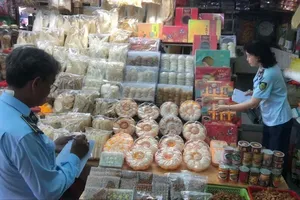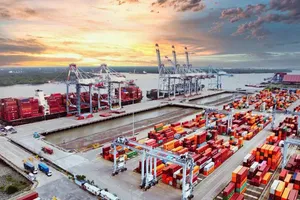
Traditional trade still accounts for approximately 70 percent of Vietnam’s retail market share, representing significant untapped potential that is attracting substantial investment from both domestic and international retailers. In the opening months of 2025 alone, retailers have poured billions of US dollars into system development and supply chain construction, with notable participation from local players.
Director Thamban Kanna Poduval of Lulu Group from Dubai offered his perspective on the Vietnamese retail landscape, emphasizing Vietnam’s rapid emergence as one of Southeast Asia’s fastest-growing markets. With a population exceeding 100 million, a youthful demographic profile, and rising per capita income, Vietnam has become a magnet for retail businesses worldwide. This invasion of global retail giants might have been expected to overshadow domestic retailers, yet the reality paints a different picture.
“The current retail landscape encompasses three primary models of big-box stores (shopping centers), small independent stores, and traditional grocery stores”, observed General Director Lam Quoc Thanh of Saigon Trading Corporation (SATRA). “Domestic retailers are accelerating their investment in shopping centers, supermarkets, and convenience stores.”
These comments coincide with SATRA’s launch of a new shopping center on Vo Van Kiet Street in District 6. Spanning nearly 30,000m² with six above-ground levels and a basement, this marks SATRA’s fourth and largest shopping center, catering to residents of Districts 5, 6, 8, 11, Binh Tan, and Tan Phu. This addition brings SATRA’s retail network to nearly 200 outlets.
Saigon Co.op, another domestic giant commodities distributor, is aggressively expanding its retail presence. January saw the launch of three new supermarkets in Thu Duc City and District 8, bringing their nationwide total to 800 outlets. As a leading Vietnamese retailer, Saigon Co.op operates diverse formats, from hypermarkets and supermarkets to shopping centers and convenience stores, catering to a wide range of consumer needs.
For 2025, Saigon Co.op plans to introduce AI-powered supermarkets, featuring AI-driven product promotion, automated payments, and personalized consumer preference recognition. Chairman of the Vietnam Retailers Association cum General Director of Saigon Co.op Nguyen Anh Duc emphasized their focus on enhancing customer experience, integrating technology, and developing e-commerce channels to effectively compete with international retailers while expanding their physical footprint.
The Vietnamese retail market has also witnessed the rise of other major domestic players, including Masan, The Gioi Di Dong, and Bach Hoa Xanh, which are continuously diversifying their ecosystems from retail to utility services through chains like WinMart and WinMart+. By the end of 2024, the King Food retail chain (operating both online and offline) had reached 80 supermarkets across HCMC and Binh Duong Province within just six years of its market entry.
Analyzing the overall landscape, statistics from the Ministry of Industry and Trade in 2024 indicates that Vietnam’s total retail sales of goods and consumer service revenue reached an estimated US$350 billion, an 8.8-percent increase compared to 2023. E-commerce continued its robust growth trajectory, with online retail revenue expanding by 20 percent to reach $20.5 billion. This growth is fueled by recovering domestic consumer demand and a thriving tourism sector, with international arrivals reaching nearly 18 million, a surge of nearly 40 percent compared to 2023.
General Director Nguyen Anh Duc noted the Government’s supportive policies for the domestic retail market, including tax reductions, incentives for foreign investment, and improvements to the business environment.
Early in 2025, the Ministry of Finance abolished Decision No. 78/2010/QD-TTg (dated November 30, 2010), which exempted import duty and VAT on imported goods valued under VND1 million ($40) sent via express delivery services. This change means all imported goods, regardless of value, are now subject to import duty and VAT, leveling the playing field between imported and domestically produced goods and contributing thousands of billions of dong annually to state revenue.
More notably, the Ministry of Industry and Trade has implemented numerous programs and policies to bolster the Vietnamese retail industry, in line with the Prime Minister’s directives on the Domestic Trade Development Strategy through 2030, with a vision to 2045.
A key initiative is the National Trade Promotion Program, which encompasses trade fairs, product promotion campaigns showcasing domestically produced goods, and training programs related to trade promotion. This is complemented by the implementation of the domestic market development project linked to the “Vietnamese People Prioritize Using Vietnamese Goods” campaign (2021-2025), aimed at developing a stable and sustainable distribution system for Vietnamese goods and enhancing the competitiveness of Vietnamese businesses and products.
To further strengthen “purely Made-in-Vietnam” retail, the Ministry of Industry and Trade as well as relevant authorities should commit to direct investment and support for the domestic retail industry to improve its competitive edge against foreign retailers.
This includes implementing flexible and appropriate financial policies for retail business loans, particularly for small, micro, and very small enterprises, as well as individual business owners, including credit guarantee mechanisms and access to financial funds. Simultaneously, in this fiercely competitive environment, retailers themselves must adapt and innovate.
General Director Duong Minh Thong of Lyon Agency, Vietnam E-Commerce Association, observed that Vietnam’s retail system has undergone a dramatic transformation over the past decade. The shift from traditional stores and markets to modern formats like shopping centers, convenience stores, supermarkets, and e-commerce has reshaped consumer behavior. Investors now require long-term development strategies, operational flexibility, and sensitivity to the constantly evolving market.
























